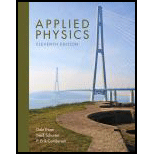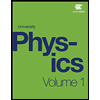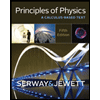
Sean and Greg are on a job site standing on two beams 11.0 ft apart. They need to lift their crate of tools midway between them with ropes up 33.5 ft to where they are working. (a) What is the angle between the ropes when the crate is on the ground? (b) How much force do Sean and Greg need to exert on the ropes when lifting the 115-lb crate off the ground? (c) How much force do both Sean and Greg need to exert when the crate is 5.75 ft below them? (d) Explain why the force to lift the crate changes as it moves closer to them.
Want to see the full answer?
Check out a sample textbook solution
Chapter 7 Solutions
Applied Physics (11th Edition)
Additional Science Textbook Solutions
An Introduction to Thermal Physics
Essential University Physics: Volume 2 (3rd Edition)
The Cosmic Perspective
Introduction to Electrodynamics
Essential University Physics (3rd Edition)
Physics for Scientists and Engineers: A Strategic Approach, Vol. 1 (Chs 1-21) (4th Edition)
- In a tug-of-war game on one campus, 15 students pull on a rope at both ends in an effort to displace the central knot to one side or the other. Two students pull with force 196 N each to the light, four students pull with force 98 N each to the left, five students pull with force 62 N each to the left, three students pull with force 150 N each to the right, and one student pulls with force 250 N to the left. Assuming the positive direction to the tight, express the net pull on the knot in terms of the unit vector. How big is the net pull on the knot? In what direction?arrow_forwardCheck Your Understanding Find the angle between forces F1and F3in Example 2.16.arrow_forwardA uniform plank of length 2.00 m and mass 26.0 kg is supported by three ropes, as indicated by the blue vectors in the figure below. Find the tension in each rope when a 710–N person is d = 0.500 m from the left end. Answer the 3 boxes below:arrow_forward
- A communications tower is located at the top of a steep hill, as shown. The angle of inclination of the hill is 62°. A guy wire is to be attached to the top of the tower and to the ground, 163 ft downhill from the base of the tower. The angle formed by the guy wire is 10°. Find the length of the cable required for the guy wire.arrow_forwardA 1350N window washers platform, 3.5 m long is suspended by two vertical wires at its ends. A 600N person is standing 2.0m form the right end. What are the tensions on both sides in two wires?arrow_forwardA 185 N sign is supported by two ropes. One rope pulls up and to the right ?1=29.5∘ above the horizontal with a tension ?1, and the other rope pulls up and to the left ?2=42.5∘ above the horizontal with a tension ?2, as shown in the figure. Find the tensions ?1 and ?2.arrow_forward
- The horizontal boom supporting a lamp is of uniform construction and weighs 50 N. If the lamp weighs 150 N, what is the tension in the supporting cable?arrow_forwardThe two forces shown act at point A of the bent bar Determine the resultant R of the two forcesarrow_forwardTwo forces act on the hook. Determine the magnitude of the resultant forcearrow_forward
- A person who mass is m=72.0kg steps onto a mechanical bathroom scale on an incline at an angle of 28.1deg with the horizontal. What is the reading on the scale?arrow_forwardVector F1 = 625 N makes an angle of 270 degrees when rotated counterclockwise from the +x axis. Vector F2 = 875 N makes a 120 degree angle from Vector F1 when rotated counterclockwise. What is the direction of the vector needed to balance the two forces?arrow_forwardFrom the given figure, a screw attached on a concrete is subjected to forces F1 and F2, 4.1 Determine the magnitude and direction ofthe resultant using the component method. 4.2 Determine the magnitude and direction ofthe resultant using the parallelogrammethod.arrow_forward
 University Physics Volume 1PhysicsISBN:9781938168277Author:William Moebs, Samuel J. Ling, Jeff SannyPublisher:OpenStax - Rice University
University Physics Volume 1PhysicsISBN:9781938168277Author:William Moebs, Samuel J. Ling, Jeff SannyPublisher:OpenStax - Rice University Principles of Physics: A Calculus-Based TextPhysicsISBN:9781133104261Author:Raymond A. Serway, John W. JewettPublisher:Cengage Learning
Principles of Physics: A Calculus-Based TextPhysicsISBN:9781133104261Author:Raymond A. Serway, John W. JewettPublisher:Cengage Learning

